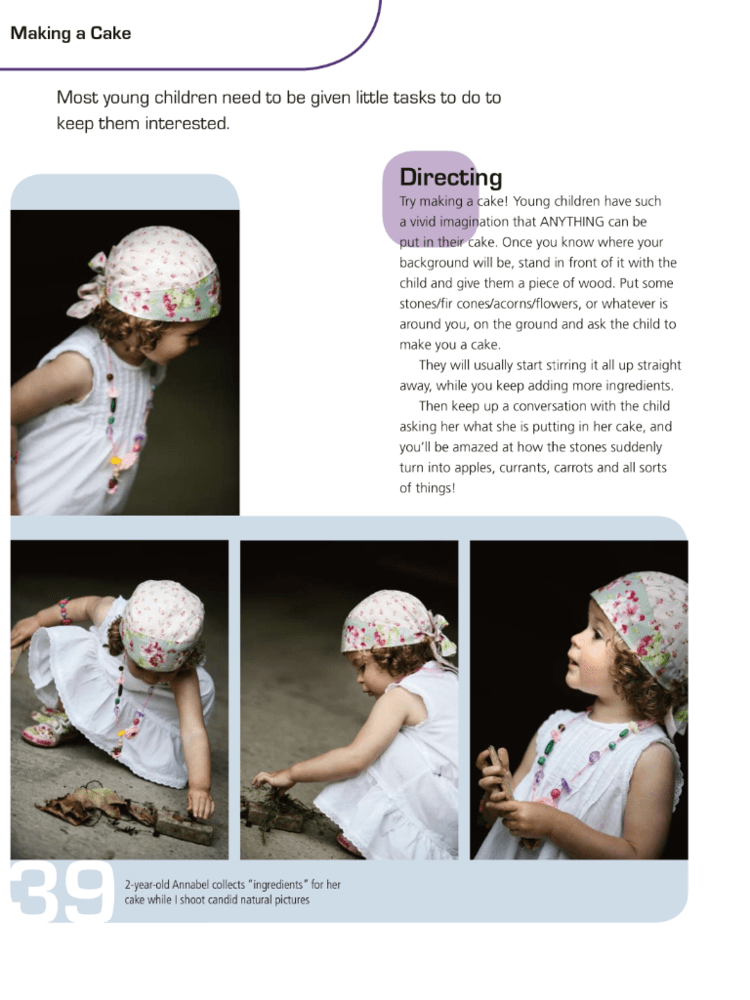HOW TO: Photograph children of different ages
There’s a definite difference between working with those under 5 and those over.
Check out this video which shows you the different ways of working with different age groups…
Video: Matt Pluck with Charlotte Griffiths / Editing: James Robinson
Ages 1 – 5 years
Children in this age group really want to do their own thing! But they can still be directed. Here are some important things to remember:
1. Make sure you choose your backgrounds/locations first so you always know where you are going next, particularly when the child gets bored – it will make it so much easier if you already know where you want to shoot.
2. Choose clothes with the child – go to their wardrobe and ask them which are their favourite dresses/T-shirts etc. and let them be part of the process – this will result in them being much more likely to change their clothes.
3. Save the best til last – if they want to wear their pink tutu with their yellow wellies – then let them (it will look fab!) – but only at the end of the shoot – otherwise you will never get them out of it! Say, “Ok, we’re going to wear this lovely blue dress first, then, we’re going to put the tutu on.”
4. Be firm but kind – don’t ask children if they will do something for you – the answer will usually be “No” – because they want to be in control! If you say, “Can you put this dress on?” they may say, “No.” But if you say, “Which dress do you want to wear – this one, or this one?” they will usually choose one of them.
5. How you react to a young child within the first 5 minutes of meeting them will set the scene for the rest of the shoot. So, if you turn up at the house, and the child is clinging to his mother’s leg – this means he is apprehensive and slightly nervous. He may be a really noisy child normally, but at this stage he is not sure who you are, or what you are going to do. I tend to acknowledge kids when I first see them – with a quiet “Hello” and then ignore them, and continue talking to their parents. Eventually they get too curious, and want my attention, so they start to come over to me, and at this point I then chat back to them, but still cautiously, so I don’t frighten them. It’s really important not to ‘coochy coo’ at them, and become overpowering.
6. Remember you don’t have to get the whole child in the shot – so if they won’t stay in one place, let them sit on their tricycle for example, and just zoom into their face. You can also put the child on Dad’s shoulders and get Dad to sit or crouch on the floor (so you can shoot down on the child – makes their eyes look bigger) – you can take pictures with Dad in, but also just zoom into the child’s face too.
Try placing the child on Dad’s shoulders, then zoom in to get a great close up shot of him while he’s happy!
7. Once I feel they are starting to relate to me, I often say, “Right, I need someone very big and clever who can show me their playhouse in the garden – I wonder who that could be?” – and you’d be amazed how many times they leap up and shout “Me! Me!” – then we’re off, and I wander round the garden with them looking for locations, whilst they ‘take control’ and show me all their favourite places – again all this is getting them to feel part of the shoot, and make it an enjoyable process rather than ‘the photographer coming to take their photo’.
8. I tend to choose 3 locations and then select 3 outfits to contrast or blend with the backgrounds. I find backgrounds which have consistent soft light, so that it doesn’t matter where the child moves around in the background, I will be able to get a good picture. We can be flexible later, but if you know where you’re going next it really helps you, rather than having to think on your feet.
9. Giving the child something to do really helps – try making a ‘cake’ by giving the child a stick, then putting little stones on the floor, and asking him to stir up the ‘mixture’ and make a cake (see below). This will keep them in one place and interested for at least 5 minutes! While they are stirring up the ‘cake’ ask them questions like, “Is it a birthday cake?” “Is it for mummy?” etc. and they will often look up at you so you can get the shot. Don’t forget to take shots of them looking down at the same time, as this is a chance for you to capture lots of cute expressions, and natural looking shots.
‘Making a cake’ works every time with little children. Let them play, and you’ll get some natural, candid shots.
10. Remember to keep your shooting time short and snappy – you constantly need to change pace, backgrounds and clothes to keep little children interested. Take refreshment breaks – go and get a drink and a biscuit, and then continue shooting later. Don’t be tempted to give kids sweets while you are trying to shoot – they will just want to eat the whole bag, and you can’t get great shots if they are chewing. Bribe them instead – “Let’s just play this game, then we will go and get a biscuit.” etc. Don’t say, “Let’s just take this photo” – they will usually say, “No” – make everything a game, it’s what young children understand.
Ages 5 and over
Children over 5 tend to look to you for direction. An 8 year old is very unlikely to ‘make a cake’ or just wander around aimlessly while you snap away. Many of the tips above for under 5’s still apply to the older ones too. But the main difference is that the older age group will work with you if you develop the right relationship with them.
1. From the start, you need to be interested in them, but not patronising – don’t treat them like little kids, or they will not respect you. Ask them about what they like doing, do they have a horse, or a bike for example?
2. Girls and boys are quite different too – girls will tend to pose for hours and love doing their own ‘fashion shoot’ – I find boys have much less concentration with photo shoots, they like it for a short while, but soon get bored! Of course there are exceptions to every rule – nowadays you are very likely to find an 8-year-old boy in front of the mirror sorting his hair gel out! Once you get over the embarrassment factor, most boys start to enjoy the shoot. See Help! I’ve got a teenager! for more ideas which work for boys over 8 too.
Ideas for older children
3. I often find that their parents want them in clothes the kids themselves don’t want to wear – so we have to compromise. I will take the child on one side and say, “Tell you what, you wear your Mum’s favourite outfit first, then you can choose whatever you want to wear – no matter how scruffy it is – deal?!” This usually works.
4. Again – it really is vital that you come across to older children in the right way as soon as you meet them. You don’t know what they’ve been told before you get there – many parents will say to their kids, ‘You’ve got to behave today – don’t let me down – the photographer’s coming!” etc. which means they often don’t like you before you’ve even arrived! So to prove you are a nice person, you need to meet them without your cameras! Just be yourself, chat to their parents and then chat to them while you look for locations, and discuss clothes with them. Ask them which clothes THEY like themselves – get them involved; don’t just deal with their parents.
5. Tell them they are going on a fashion shoot and can wear whatever they like – and then go and help them choose. Make the whole thing fun. Takes crisps and drinks with you – check with their parents that you can feed them rubbish for the day, as it will work much better!!
6. If there are several children, build up a shape by starting with the tallest child first – perhaps get them to lean against a wall with their hands in their pockets. Then take the next tallest child and lean them against the first one, perhaps with their arms folded.
7. Try the same thing only sitting on the floor – start with the tallest child, and then build the others into a shape that looks good. Ask them all to cuddle in together, or lean their heads together, just before you take the shot – so the positioning looks more natural.
8. If you are using F5.6 as I suggest in Set up your camera the easy way… then you need to make sure the children’s heads are in the same “plane” – so they are all in focus – try asking the ones at the back to lean their heads forward.
9. Walk around your subject and shoot pictures from different angles while they stay in the same position. Move their head to the left or right, change their expression, get them to lean on their knee etc – and you’ll get a variety of different shots without changing the background or light. Then move onto another background/outfit and change the look.
10. Get the kids to make suggestions of their own – particularly near the end of the shoot – you can often get some really fun pictures from experimenting once the pressure is off.
All images are taken from ‘99 Portrait Photo Ideas’
Click here for more information about 99 Portrait Photo Ideas
For more tips on photographing children go to 10 top tips for getting great photographs of children








